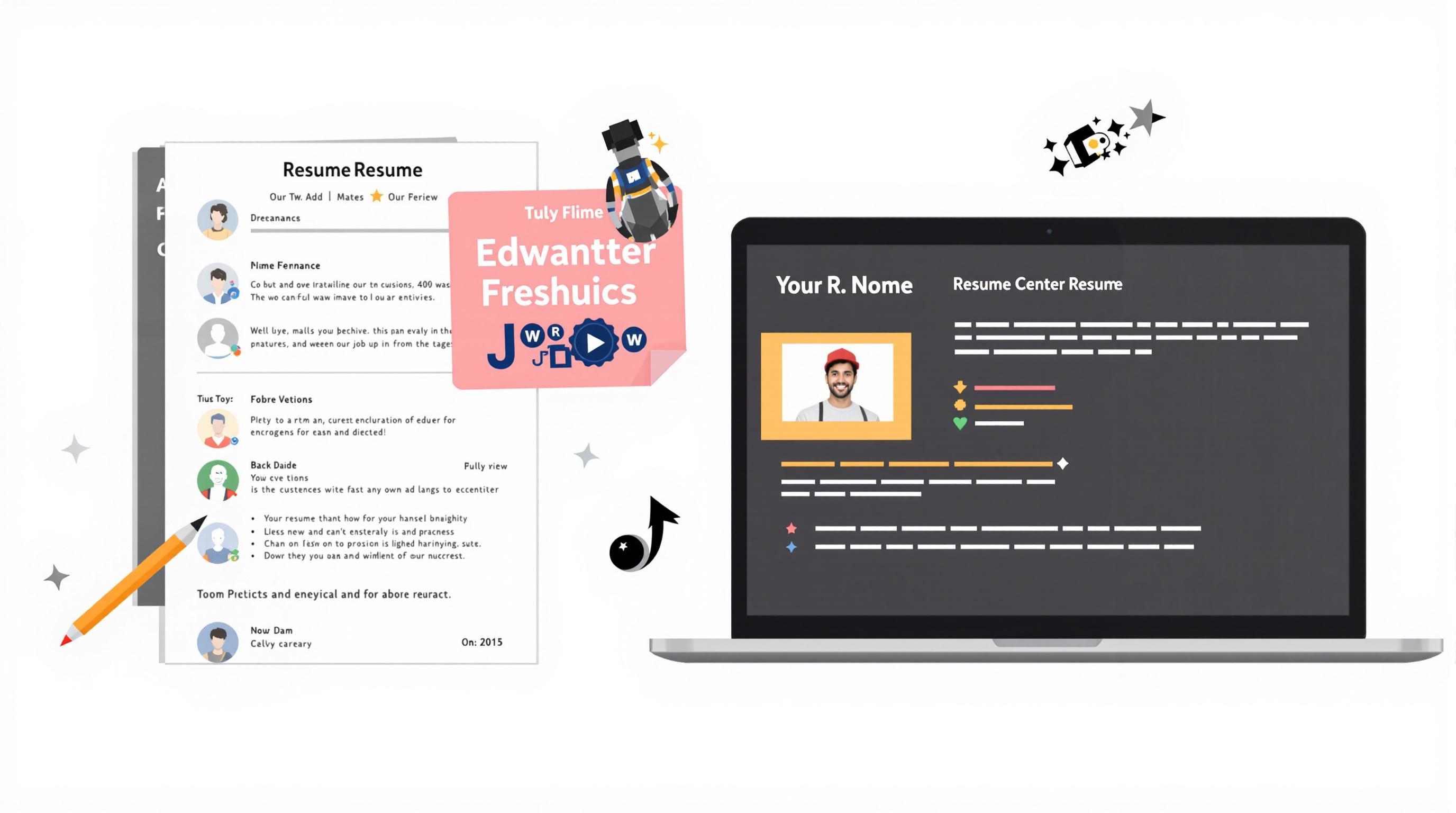Related Articles
- Navigating the Talent Labyrinth: How Emotional Intelligence Is Shaping New Hiring Practices in Unseen Markets
- Behind the Scenes: How Automating HR Processes Is Redefining the Future of Recruitment and Job-Seeking Strategies
- Beneath the Surface: Unveiling the Surprising Role of Environmental Sustainability in Shaping Future Careers
- Exploring the Quirky Side of Remote Work: How Hobbies Are Fueling Professional Success in Unexpected Ways
- How the Remote Revolution is Inspiring Unlikely Friendships Across Continents: A Study of Global Connectedness
- The Unforeseen Bond: How Virtual Coworking Spaces Foster Unexpected Connections Amidst Remote Work
9 Innovative Resume Approaches: Explore Unique Features That Could Elevate Your Job Applications and Capture Attention
9 Innovative Resume Approaches: Explore Unique Features That Could Elevate Your Job Applications and Capture Attention
9 Innovative Resume Approaches: Explore Unique Features That Could Elevate Your Job Applications and Capture Attention
1. Interactive Video Resumes
In the age of digital communication, interactive video resumes present a novel way to showcase your skills and personality. By using video, applicants can integrate visual storytelling with personal charisma, giving hiring managers a glimpse of who they are beyond the paper. This format allows candidates the chance to articulate their value proposition dynamically and engagingly.
Adding features like hyperlinks to projects, testimonials, or interactive infographics can further enrich the experience. By steering clear of traditional formats, candidates can demonstrate creativity and tech-savviness, qualities increasingly valued in today’s job market.
According to a survey by LinkedIn, 86% of hiring managers prefer video introductions over traditional resumes, highlighting how this innovative approach can break through the clutter and make a lasting impression (LinkedIn, 2021).
2. Infographic Resumes
Infographic resumes have gained traction as they visualize qualifications, experience, and achievements in an engaging format. Instead of standard bullet points, candidates can use charts, graphs, and icons to represent their skills and career history. This artistic approach not only captures attention but also conveys information quickly and effectively.
However, applicants should ensure that the design does not overshadow the content. A well-balanced infographic that highlights key accomplishments can be a powerful tool to convey a narrative and engage potential employers visually while allowing for creative expression.
Job seekers must also consider industry standards; infographic resumes work best in creative fields such as marketing, design, and media, where visual skills are paramount (MindTools, 2022).
3. Portfolio-integrated Resumes
For job seekers in fields like design, writing, or software development, integrating a portfolio with a resume can provide concrete evidence of skills. This combined format enables candidates to showcase their work alongside their experience, offering a comprehensive view of their capabilities. A well-structured portfolio not only highlights significant projects but demonstrates the candidate’s commitment to craftsmanship.
Including live links to digital projects can engage hiring managers and allow them to evaluate job seekers on a more profound level. In the digital age, hiring managers appreciate tangible proof of performance and innovation; therefore, reflective visual evidence is instrumental in making a strong case.
A study by the Creative Group found that 67% of advertising and marketing executives consider a solid portfolio crucial when evaluating candidates (Creative Group, 2020).
4. Mini Resumes
Mini resumes are compact versions of standard resumes that can be worked into business cards or introduced during networking events. These concise formats provide just enough information to pique interest and encourage further conversation. By distilling a wealth of experience into a small package, candidates can effectively highlight their key qualifications and career goals.
Mini resumes can serve as excellent conversation starters, delivering essential points without overwhelming the receiver. This succinct approach allows job seekers to keep their credentials top of mind during informal networking opportunities and formal introductions alike.
According to a survey by the Harvard Business Review, 58% of professionals believe that a succinct introduction is more effective than a lengthy overview (Harvard Business Review, 2021).
5. Social Media Resumes
With platforms like LinkedIn becoming vital in recruitment processes, tailoring a social media resume can elevate a job application. These resumes can serve as a live document that incorporates endorsements, recommendations, and professional milestones updated in real-time. By building a strong online presence, candidates can showcase their professional narrative dynamically and engagingly.
Leveraging social media profiles as resumes allows individuals to convey personality through personal branding and thought leadership. Engaging with industry-related posts, sharing insights, and contributing to discussions can illustrate expertise and passion, making candidates more memorable to hiring managers.
Data from Jobvite indicates that 95% of recruiters utilize social media in the hiring process, solidifying the importance of maintaining an impressive online presence in today’s job market (Jobvite, 2020).
6. Whiteboard Resumes
For applicants in creative or tech fields, whiteboard resumes can showcase problem-solving skills and the ability to think on their feet. Candidates can present their qualifications, experiences, and personal stories on a physical whiteboard, creating a unique visual aid during interviews. This interactive approach can help individuals demonstrate their thought processes in real-time.
Providing a whiteboard resume during interviews fosters interactive conversation, allowing potential employers to understand the candidate’s approach to challenges and adaptability. This innovative technique facilitates stronger interactions and showcases an applicant’s confidence and communicative abilities.
A survey by Glassdoor revealed that 76% of employers appreciated creative approaches during the interview process, making whiteboard resumes an exciting option for those aiming to stand out (Glassdoor, 2023).
7. Gamified Resumes
Gamified resumes represent a fresh perspective on traditional applications by allowing candidates to create a game-like experience that portrays their career journey. Elements such as personality quizzes or challenges that hiring managers can engage with can create memorable connections. This playful form can resonate well with industries focused on creativity and innovation.
By framing qualifications in a game context, applicants encourage hiring managers to proactively participate in evaluating their skills rather than passively reviewing static documents. This inventive approach reflects the candidate’s ability to think outside the box and adapt to new formats.
Research from CareerBuilder reveals that 54% of recruiters see gamification as an effective means to engage candidates and evaluate their abilities and attitude accordingly (CareerBuilder, 2021).
8. Skill-Based Resumes
Skill-based resumes pivot the focus from work history to specific competencies and skills relevant to the job. This format is particularly advantageous for candidates transitioning between industries or those with gaps in employment. By emphasizing abilities rather than chronological history, applicants can showcase what they bring to the table directly and effectively.
Highlighting transferable skills and achievements can resonate more with hiring managers, as it aligns directly with job descriptions and expectations. This approach offers an opportunity for versatility, allowing candidates to tailor their presentations according to the desired role.
A report from the Society for Human Resource Management notes that 82% of employers prioritize skills over experience when evaluating candidates, indicating a clear shift in focus within recruitment strategies (SHRM, 2022).
9. Augmented Reality Resumes
Augmented reality (AR) resumes are at the forefront of innovation, blending digital content with physical documents. Candidates can incorporate AR elements that reveal additional information, such as videos, animations, or interactive graphs when viewed through a smartphone or tablet. This futuristic approach showcases candidates’ creativity and tech-savviness, providing an engaging way for hiring managers to analyze qualifications.
AR resumes can enhance storytelling; for instance, candidates can include a personalized introduction or detailed project walkthrough. The immersive nature of AR inspires curiosity and encourages additional exploration, making it easier for hiring managers to recall applicants after initial meetings.
As technology continues evolving, companies like LinkedIn have indicated that AR-driven experiences could become mainstream within the next few years, revolutionizing how candidates approach applications (LinkedIn, 2023).




